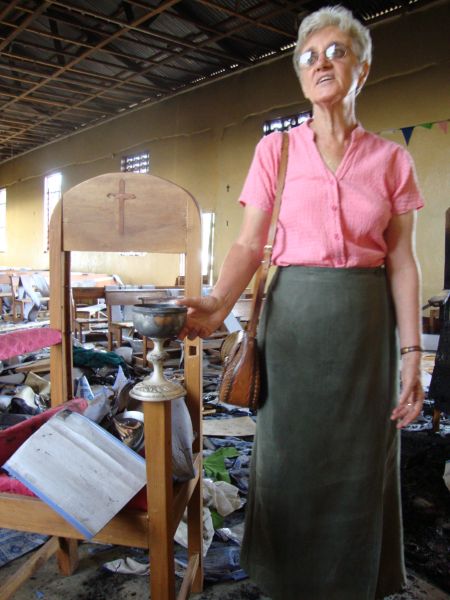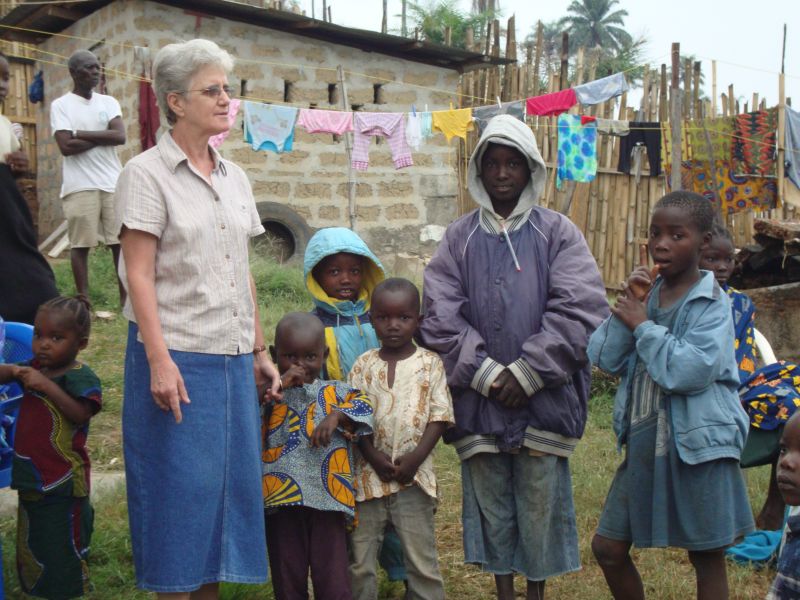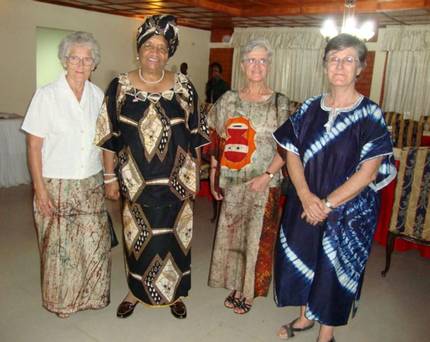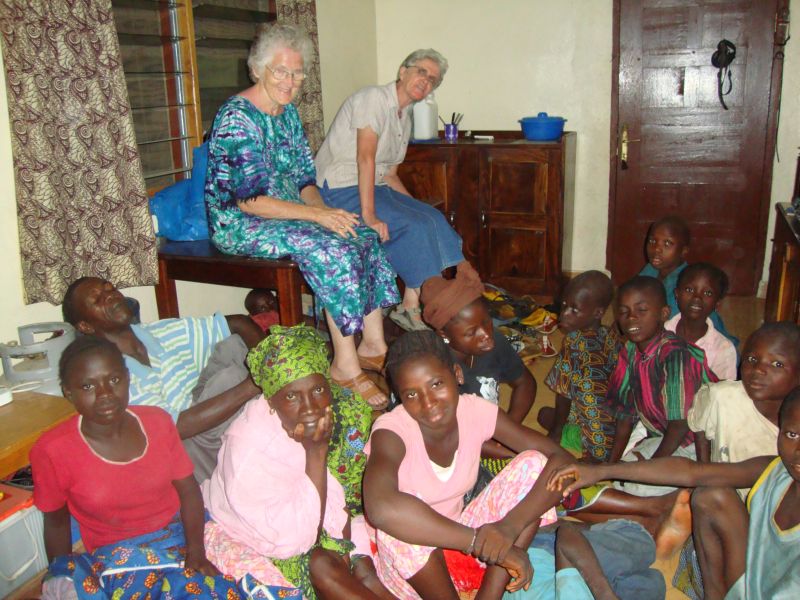Rachel Lavin interviews three Irish nuns who are dealing with the Ebola crisis on their mission in Liberia
Words| Rachel Lavin
The Holy Rosary Sisters’ Convent is a humble and unassuming 1950’s style house based amidst a maze of suburban housing estates in Artane. After struggling to find it, and with few locals even realizing it existed when I asked them for directions, I finally make my way past the high walls, and through a large wrought iron gate, into the immaculately kept garden. Quieter now, with the screaming of children and hum of cars from the main road suddenly seeming miles away, I am greeted politely by three elderly nuns who are out in the cold November air gardening. I make my way up the driveway, past the parked Nissan Micras outside, and ring the doorbell of the large front door.
Sister Mary Mullin had sounded a bit stern on the phone, perhaps a bit suspicious of why I was calling her and certainly seemed to have more important things to do, such as fighting for more awareness and funding for her mission in Liberia, now besieged by the Ebola epidemic, so I’m a bit worried she may not have much patience for me. But no sooner as the door opened than I am warmly welcomed with ‘sweethearts and darlings’ and am ushered to what I perceive to be the ‘good room’, a pristinely clean and orderly sitting room full of matte greens and pastel pinks.
Sister Mary herself looks to be in her late seventies (not that I dare ask), has a carefully coiffed grey perm and an air of authority about her, that perhaps comes from her forty years experience as a missionary in Africa. She begins ‘As a missionary sister of the Holy Rosary our thrust has always been to work with the most disadvantaged and marginalized and that means in good times and bad times.’
‘
“We just gave up what we were doing and took on Ebola.”
And bad times, there has been plenty. When Mary began her mission in 1966 at the age of 24 she found herself abroad for the first time in Nigeria, which was on the brink of the Biafran war. Before the end of her first year fighting broke out and she and other Sisters had to escape overnight under gunfire ‘down the creeks across West Africa’.
She later faced further challenges when based in Sierra Leone as thousands of refugees fled across the border to Guinea due to civil war. She went with them, setting up wherever the refugee camps did and continuing her work as an educator and school teacher. When peace was restored to Sierra Leone, the refugees began returning and Mary planned on returning with them. But as she was leaving, another flood of refugees came to Guinea, this time from Liberia. They were escaping a civil war in their own land and she decided to stay.
‘We couldn’t abandon them,’ she reflects.
When 16 years of civil war in Liberia finally came to an end in 2005, Sister Mary, along with Sister Anne Kelly from Galway city and Sister Bridge Lacey from Tipperary followed the Liberians home in order to help them rebuild their lives.
“I watched them coming back on the UN trucks and there was literally nothing. All the villages were overgrown, any buildings were run down. The trucks would just drop them at the end of the road under a plum tree and they looked around unable to recognize the place they’d left behind.’

There was no ‘mission’ set up there either, no buildings or contacts, no model for development. So the three Holy Rosary sisters decided to establish their own. However, as Sister Mary emphasizes, this would not be a ‘mission’ per sae. Rather, the nuns wanted to be able to hand over their organisation to the locals and let it be a locally run, so they set it up as a local NGO called ‘Social Empowerment Through Learning- SEL.It’s about passing on the charisma and the vision. You set up works, you train people and then you move on. That is really what it is about and if there is local teachers, local nurses, local doctors, they’re the ones to take over. So when the day comes when we can no longer be there, for reasons of health or age, the NGO will continue’.Now, as Sr. Mary explains, in Lofa county, ‘There’s only three whites and that’s the three of us, all the rest are locals. And that’s the way to go, to train people that will take over.’Following this, self-empowerment became a central focus of the nuns, and they did this through education. ‘We worked with them, setting up programs for the women especially, to give them a better life in the future’.
They taught adult literacy classes and skills training and ran small income generating projects so that the refugees could go on and set up small businesses in soap making, tailoring, weaving and basket work.
This was something Mary refers to as ‘empowering people to find solutions to their own problems’, something she taught in both her own adult literacy and primary school classes. The project grew from their center in Voinjama to the neighboring towns of Foya and Kolahun and hundreds of villages in between.
Over time, the living conditions of the people of Liberia, and especially those of the returned refugees in Lofa county, were starting to look up.
But then came the Ebola virus.
‘It was March the 25th when we first heard of Ebola in Africa on the radio.’
However Mary admits, ‘most people didn’t take much notice of it. It was an unknown and people didn’t know how to cope, didn’t realize how quickly it spread.’The virus peaked in March but died down again in June, the same time Sister Mary returned home to Ireland for the Summer while her school was closed. However it peaked again in July and August, becoming a fully-blown and out of control epidemic. Sister Mary explains multiple reasons for its rapid spread.
‘Ebola is very bad, but the poverty is worse and Ebola thrives on poverty’. Once it hit Monrovia, the capital, where there is a dense population since the war, ‘the Ebola virus just took off.’
Since that time Ebola rates skyrocketed in West Africa. Death tolls reached over 6000 and the number of those affected was three times that. Schools and markets closed and the economy disintegrated. All the while, fear began to grow,
‘When Medical Sans Frontiers were the first to arrive in their body suits the people were scared because they didn’t know what it was about. We were listening and aware all the time of the misconceptions. Fear was the greatest emotion. ‘The fear was palpable, Fear of the Ebola and fear of one another. And that is so un-African, where people are so hospitable and friendly. ‘
“Fear was the greatest emotion. They were afraid the white man was bringing the disease, that they were part of the problem”
‘They were afraid the white man was bringing the disease, that they were part of the problem. In Guinea we heard that one of the first MSF trucks was stoned, with the people telling them to leave the place’. Sister Mary explains part of this was because the medical workers treatment of bodies clashed with the Liberian ritual burials.
“Liberians have their own burial rituals where they really say goodbye to the person, wash them and hug them, otherwise they feel that the spirit of the person is not at rest and will come back. And if the spirit is not too pleased with what has happened they could bring sickness or they could bring disease’.When the locals saw white men in hazmat suits taking away sick people, many who never came back and whose bodies were withheld for them, (as their burial ritual would put them in contact with dangerous body fluids that spread Ebola), they grew increasingly agitated. While medical workers saw this as a cure to spreading more disease, many West African people believed it to be the cause.
All this time Sister Anne and Bridget were left behind in Lofa County, a region north of Liberia bordering both Guinea and Sierra Leone, – essentially at the center of the epidemic and where one the first known cases had been recorded. While Sister Mary was unable to return to Liberia as the disease became a widespread epidemic (choosing instead to raise funds and awareness in Ireland) she kept in close contact with Anne and Bridget by e-mail and phone.
Sister Mary shows me a letter sent on October 14th by them. It reads ‘Dear Sisters. Our lives here in Liberia continue to be dominated by the Ebola crisis!; We no longer shake hands or hug each other; our dead are buried by the government and we mourn quietly in our hearts as the bitter taste of Ebola reaches into our lives furtively and destructively!’
Intrigued by this passionate correspondence from the sisters, I ask for their contact number in order to find out more about the situation on the ground and a few days later I am able to talk briefly with Sister Bridget over a crackly phone line to her home in Liberia.
‘In the beginning people were reluctant to go to the treatment center in Foya and hand themselves in, ‘ she explains. ’Because they saw it as a death sentence, that they wouldn’t come back, which of course was the case for many.’
This, she attributed to a ‘lack of media and television and radio and information, good information for people to hear, you know, in these parts of the world, people just don’t get much accurate information. And that’s what we decided to try to provide- accurate information.’

In early August as the epidemic began to spread, the sisters began an Ebola awareness campaign.
‘We just gave up what we were doing and took on Ebola. I was a trained lab technician in my ‘former’ life and knew I was well able for this. Between the two of us we were knowledgeable and, with some education, we were confident that we knew what we were doing.’
‘We told people to go and get tested if they had a fever, not to be thinking it was just malaria or typhoid, but go immediately to the treatment centers set up by Medical Sans Frontiers. Early testing was the key to people recovering and preventing the spread. Once survivors began to survive and come back and that of course gave great hope to people.’
‘Now we have about 50 of the people we work with doing Ebola awareness in 200/300 villages for the last four/five months’.
As Sister Mary pointed out during our conversation, despite many people’s skepticism that Ebola was a white man’s disease, the Irish nuns were successful because they were ‘loved and trusted, and that’s why the people believed what the sisters were saying when they were giving the right version of how Ebola can be contracted and how we can avoid it. That’s why it was such a success’.
“Despite many people’s skepticism that Ebola was a white man’s disease, the Irish nuns were successful because they were ‘loved and trusted.”
Sister Bridget shirks any flattery though and credits the local people for handling it so well.‘The people we are working with have really done very very well considering they were so fearful in the beginning. People are accepting it more now. For many, their families have been affected with it so it’s changing. With time people begin to understand and accept it.’As well as working to prevent Ebola, the sisters also worked with the survivors who faced huge problems when returning to normal life in the rural villages.‘A lot of their stuff, clothes and phones and all those things, are usually burned; sprayed with chlorine and destroyed because of the virus. You know you go to a treatment center with nothing and then you come back with nothing, only whatever clothes they give you. We would try to help people, when they came back, to get the basics, you know, pots and pans, things like that.’
Mostly however the sisters worked on reducing the stigma returning survivors faced, as many African cultures believed the virus to be a ‘bad sign’ or that the person was still contagious.
Instead the campaign explained ‘that the person coming back having recovered and surviving Ebola is not a danger to anybody. In fact, they are immune to Ebola once they survive it and so in coming back they are an asset to the community. Because if, by chance, anybody gets Ebola in that village, that person will be able to take care of them there, as an alternative to the treatment center.’
Of course, it’s not just the survivors that need rehabilitation; there are many orphans too, which the Sisters set about temporarily caring for in their centers while they sought family links to re-locate them.
“A lot of children have been left, especially those who were living only with their mother and the mother has died. So we have been trying to get those children connected to their extended family. Recently there was one child from a family in Liberia, a five year old boy, the only survivor as everyone in his immediate family had died. So we had him for about a month, trying to find out who he was and where his family was, and we eventually found his aunt in Monrovia who adopted him.’
It’s not just re-locating the children but dealing with the trauma the epidemic has caused too.
‘The children were particularly traumatised. ‘When they hear an ambulance they just run away. As the little boy said “the ambulance came, took all my family and nobody came back.” They all died, about eight of them.’
This number of deaths in a family was not uncommon. I ask Bridget about a particularly sad detail she wrote in her letter, saying ‘Families have sick relatives in their houses and the ambulances are not able to take them to the treatment centers because they are really overcrowded. They just lock the door and abandon the relative who is dying of Ebola! The trauma is overwhelming and they are left with the memory for the rest of their lives’.
She says ‘This was not the case in Lofa, but in Monrovia (the capital city) yes,’ she sighs. ‘The treatment for the first few months was really bad in Monrovia. There was only one treatment center and they could only take 70 or 80 people. And they needed 1,000/1,500 beds. If you presented yourself at the treatment center, they just told you sorry, so you just had to go home. And you die. And hopefully, family would have put themselves apart so as not to infect other people, but more than often it was that once the virus got into a house the whole house was wiped out. It nearly happened all over, 8, 12, 14 people in a house died.’
Poor health facilities and overcrowded treatment centers lead to a lot of unnecessary deaths, both from Ebola and, when general hospitals closed down, the lack of treatment available for other illnesses.
Bridget explains ‘About August/October all the health services in this country were closed because they weren’t equipped. The people needed equipment you know the suits and the masks and the gloves and everything. And hospital staff never had to deal with this in Liberia before. They were not trained for this. So all the hospitals were closed. People couldn’t even get admitted to an Ebola treatment center, they’d be declined and then bodies would be left on streets. Even if you had an appendix or were a pregnant woman, well sorry for you, nobody could do it.’
“The children are particularly traumatised. When they hear an ambulance they just run away.”
Sister Mary told me in conversation how she had been personally affected by this crisis, when, a hospital in Monrovia where she often stayed overnight on her journey to the airport before flying home, was overwhelmed by Ebola but under-equipped to handle it. Sixteen members of staff died, everyone from the security guard to the social worker, including four John of God priests Sister Mary knew well. Sister Mary became tearful as she explained ‘they’re the real Ebola heroes you know.’ The hospital shut down as a result and now Sister Mary is fundraising to help it reopen and have it properly equipped.However once the hospitals re-open Sister Anne and Bridget have to eradicate the fear of hospitals that developed after all the Ebola-related deaths in connection to them. They found this to be especially important for vulnerable pregnant women who they noticed were not going to checkups.’
‘Since the hospitals and clinics reopened we were encouraging people to go for their check-ups because people were afraid to go to the hospitals, afraid they would get Ebola, even though there were no Ebola patients in the hospitals. People were still afraid but in one’s and two’s they started going back to the clinic.’
‘For now’ Bridget explains, ‘people are better, people are better informed and better prepared.’
I can’t help but ask, didn’t the sisters ever worry about own health?
‘Yeah we were,’ admits Sister Bridget, ‘but as time goes on you get used to it. We had to be mindful of our limits. You can do something but you don’t have to put yourself in danger. We were careful.’
‘Thank God nothing has happened to us, we were never quarantined under 21 days. We’ve been very fortunate in that way, even though we were out and about, and were never so busy in all our lives than we were here in the past six months.‘
In light of all this hard work, Bridget was relieved to tell me the latest news from the ground in Liberia.
‘All over Liberia the death toll is falling’.
‘
“‘All over Liberia the death toll is falling’.”
However, Bridget is cautious in her celebration.‘It is hard to know how that will work out. It kind of happened a bit suddenly, numbers started to drop but nobody is really able to say why it has dropped. If it has dropped suddenly like that there’s the possibility that it can shoot back up. But we’re hoping that it will stay down. Until there’s no trace of Ebola for 42 days, Liberia is not free of Ebola. But Liberia will not be free until there is no trace in Guinea or Sierra Leone. That’s where it is all connected.’
Even if Ebola is cured however, the sisters are acutely aware that their work is only beginning.
‘It will take people a long time to recover from it, being a survivor or a quarantined person or an orphan. People will be talking about it, going through this, especially survivors, they will find it very difficult even just to get back into the normal routine. As well as that, the economy of this country is gone wallop since Ebola struck and it was just kind of getting on its feet. So the condition and the lifestyle of people is really terrible and people are very very poor. ‘
As our voice reception gets crackly I must say goodbye to Sister Bridget. But her speaking of getting things back to normal, reminded me of something Sister Mary had said during our interview, something she’s been keeping from the sisters until now.
‘Are you Going Back?’ I ask.
‘I am darling. My two companions don’t know this yet but I was thinking of going back this January.
‘Earlier (in August) they said no because I had finished my programs with the SEL. We had made enough soap to flood the country, enough dresses and all that and the economy wasn’t that good anyway.
And I was doing work upgrading the teachers in the primary schools, but when I returned to Ireland over the summer and the Ebola took off, schools were closed and have not yet reopened. But there is a school in Lofa county that will be reopened in January. I’m looking forward to going back.’
Sister Mary knows the place she’s returning to will be much changed however. While experts say the epidemic should be under control by mid-2015, dealing with the after–effects of the epidemic will be a long-term challenge.
‘Life post-Ebola is like post war. You know there will be children that will have lost their parents, so many children begging to go to school and it won’t be easy for the families that have adopted those children because it’s an extra mouth to feed and child to send to school. There’ll be a lot of listening too. Like the stories of war go on, the stories of Ebola will go on long after’.
“Life post-Ebola is like post war. Like the stories of war go on, the stories of Ebola will go on long after.”
Sister Mary finishes our chat by offering me a cup of tea. I pack up and make my way to the kitchen area where a whole host of elderly nuns are cluttering about, chatting politely and making tea for the evening. I am treated to tea and biscuits, while Sister Mary gets her coat. Some of the nuns kindly approach me, and after talking to each, it turns out they are all retired from or on leave from decades of missionary work in the third world. Far from the timid or gentle older women they appear to be, they are all hardened aid workers, and they regale stories of staying in Africa during wartime to protect and help civilians, escaping under gunfire, standing up to corruption and violence, trying to save the vulnerable, and sometimes, sadly, not being able to. This small collection of elderly nuns are far more worldly than perhaps I will ever be. I ask what age they began the missions? ‘24’ they say, and looking to me realizing I’m around the same age, they ask expectantly if I will be doing any aid work in the future? I’m embarrassed to say the thought hadn’t even crossed my mind. I ask what spurred them to join and aside from their devotion of God, I quickly realize that becoming a nun and a missionary was often the only way to do aid work in the fifties and sixties when they all began, even to get educated and live independently as a woman. As one Sister puts it quite bluntly. ‘I didn’t want to be a nun, but I wanted to be a missionary’, she laughs.
Sister Mary returns and with many warm goodbyes and blessings we walk through the grey suburban housing estate back to the motorway to the bus-stop. I can’t help but keep quizzing Sr. Mary as we go however. Doesn’t she ever think of retiring?
“I’ll keep going for another while.’ She laughs. ‘I will be retiring in Ireland, that I know. I’d like to be able to retire early enough to enjoy life in Ireland because I know it’s going to be a huge adjustment. From what I found in the last few months, I’ve been a fish out of water. It’s really a new culture and a new country.’
Leaving me at the bus stop she concludes,
‘It will be very hard to say goodbye to Africa but it will be full of gratitude for what Africa has given me. Even though my body may be here, my heart will always be in Africa’.
You can find out moor about the Missionary Sisters of the Holy Rosary here.








